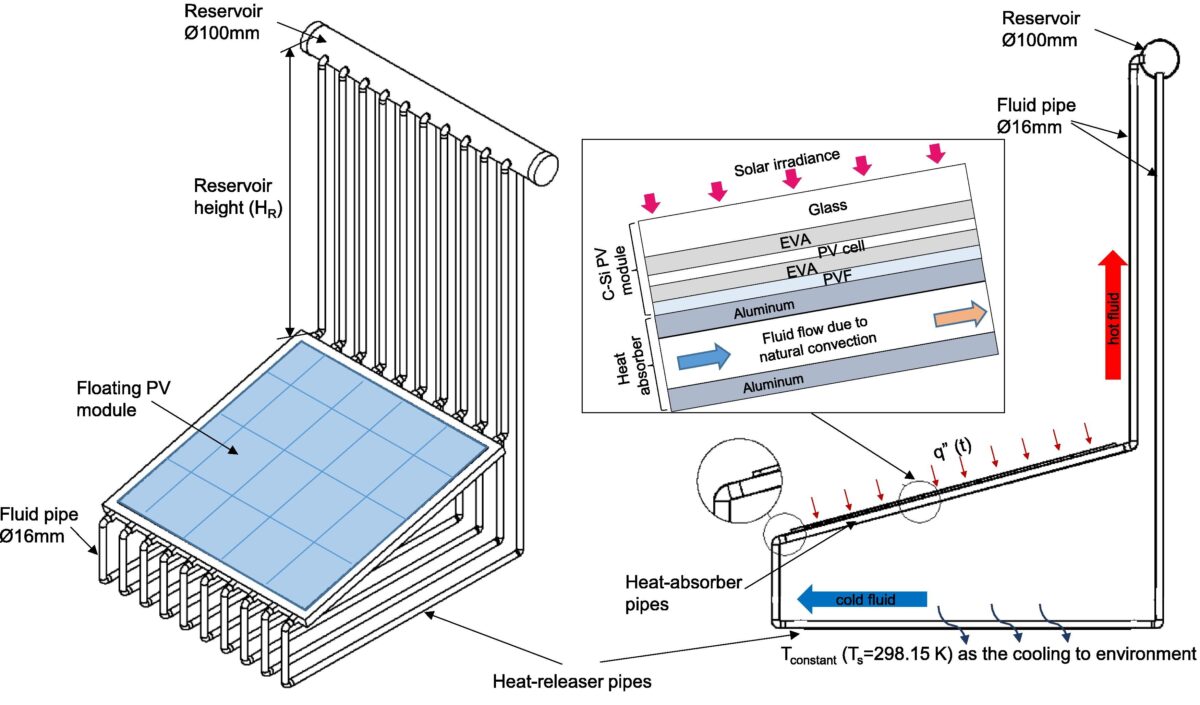An international research group led by the University of Manchester has developed a passive cooling technique based on natural convection cooling loop (NCCL) to reduce the operating temperature of floating PV systems.
In a recently published paper, the cooling technique is claimed to consist of heat absorber pipes thermally connected to the PV module, heat releaser pipes that exchange heat with the water body, a series of connecting pipes and a coolant reservoir. The system reportedly creates a continuous fluid flow that dissipates heat from the PV cells to the surroundings.
The cooling loop device consists of connecting pipes with a diameter of 16 mm, a fluid reservoir with a diameter of 100 mm, heat-absorber and heat-releaser pipes.
“The heat-absorber and heat-releaser pipes are constructed from 14×14 mm square aluminum pipes with a thickness of 0.5 mm. The cooling loop device connects the hot region at the top and the cold region at the bottom,” the paper states, noting that the heat-absorber pipes receive the thermal energy from the solar modules and then heat up the fluid inside the pipe.
The cooling loop system also comprises a reservoir at the top of the cooling loop, which creates a buoyancy-driven flow. The heat-releaser pipes are placed at the bottom and submerged in the constant temperature of the water.
The scientists conducted a series of tests of the proposed cooling technology in Bandung, West Java, Indonesia, with solar irradiance in the region ranging from 227.2 W/m2 to 1153.2 W/m2.
“The actual temperature and electrical performance of floating photovoltaic panel were measured through experiments that varied the reservoir height,” the paper states. The natural convection cooling loops effectively enhance the electrical efficiency of the floating photovoltaic panels by reducing the photovoltaic cell temperature from 318.8 Kelvin to 315.3 Kelvin. “The electrical efficiency under solar irradiance of approximately 1000 W/m2 increased by 17.84% with the introduction of a reservoir height of 750 mm.”
The group also conducted a cost-effectiveness analysis on the novel tech and said it can substantially lower a floating PV system's levelized cost of electricity (LCOE) and payback period. “In the future, the envisioned floating photovoltaic systems equipped with natural convection cooling loops could potentially evolve into multifunctional systems capable of generating both electrical and thermal energies, thereby optimizing overall energy efficiency,” the research concluded.
The cooling system was introduced in the paper “Design and analysis of passively cooled floating photovoltaic systems,” published in Thermal Engineering. The research team includes academics from the Israel Institute of Technology, the Khalifa University in the UAE, the Institut Teknologi Bandung and the Universitas Sebelas Maret in Indonesia.
This content is protected by copyright and may not be reused. If you want to cooperate with us and would like to reuse some of our content, please contact: editors@pv-magazine.com.




By submitting this form you agree to pv magazine using your data for the purposes of publishing your comment.
Your personal data will only be disclosed or otherwise transmitted to third parties for the purposes of spam filtering or if this is necessary for technical maintenance of the website. Any other transfer to third parties will not take place unless this is justified on the basis of applicable data protection regulations or if pv magazine is legally obliged to do so.
You may revoke this consent at any time with effect for the future, in which case your personal data will be deleted immediately. Otherwise, your data will be deleted if pv magazine has processed your request or the purpose of data storage is fulfilled.
Further information on data privacy can be found in our Data Protection Policy.